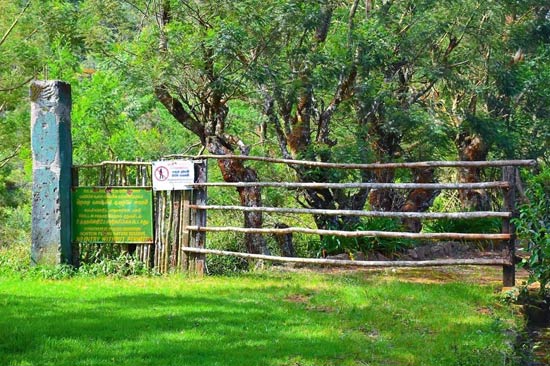Nonpareil road: A forest path to environmental disaster
Under the initiative to promote tourism in the Belihuloya region, there are plans to open a forest path from the village of Nonpareil (starting from the end of Nagrack Bungalow) to Horton Plains as part of the broader tourism promotion in the Belihuloya area.
The non-forest section of this route refers to the stretch from the Badulla-Colombo road junction with Nonpareil village, considered one of the highest villages in Sri Lanka, approximately 5,000 feet (1,500 metres) above sea level. This section is classified as non-forest because it has a road suitable for vehicles. However, this road passes through the proposed Raththanagolla Reserve Forest and the Peak Wilderness (Sri Pada) Reserve. Nonpareil village falls under the Galpoththanna Grama Niladhari Division, with the highest part of the village known as the Nagrack Division.

The DWC no entry board
The plan is to open a path from the end of Nagrack Bungalow to World’s End for tourism activities. This path has been proposed on several occasions, most recently in 2020 by the Imbulpe Pradeshiya Sabha and its chairman. However, strong opposition, including from the Department of Wildlife Conservation (DWC), halted the move. The path, spanning approximately 2-2.5 km through the montane cloud forest, lies within a highly sensitive ecological zone connecting Horton Plains and the Sri Pada Reserve.
The proposed forest section is considered a sensitive ecological zone for several reasons. It serves as a migratory passage for wildlife, as well as breeding and feeding grounds. Additionally, the Belihuloya River, which originates in Horton Plains, flows through this area. While extensive grasslands with minimal forest cover characterise Horton Plains, this section has dense forest cover, supporting rich biodiversity.
This area is home to a significant leopard population and, according to researchers, a subspecies of the red slender loris known as the montane slender loris, a rare mammal. Other mammals found here include the sambhur deer, toque macaque, large forest squirrel, dusky striped squirrel, golden palm civet, and endemic species like the Sri Lankan spiny mouse.
It also has lichens, some of which are unique to this area and endemic to Sri Lanka, according to researchers. The region is rich in ferns, orchids and other flora, with many species endemic to Sri Lanka.
Of the nearly 20 amphibian species recorded in the area, 19 are endemic, including the Sri Lankan montane frog and the Horton Plains shrub frog (Pseudophilautus alto). Nine out of ten recorded reptile species are also endemic. The abundance of lichen-covered trees and shrubs supports species like the rhino-horned lizard and the pygmy lizard (Cophotis ceylanica) that use them for nesting and food. Many squirrels and birds use lichens for cushioning and patching their nests to camouflage them. Moths and butterflies also feed on lichens – all underscoring the region’s ecological value.
Even if this path is opened under strict regulations, minimis ing environmental damage would be near impossible. Visitors breaking branches or picking flowers, is a common issue at Horton Plains, even though the park is managed by the DWC. Poaching and illegal collection of genetic material, are also a concern, with past incidents of plant and animal sample theft leading to hefty fines. Even if the proposed plan limits access to 100 tourists per day at $50 per entry per person, regulating such activities would be challenging.
The area is a critical water catchment zone, and increased human activity would degrade soil layers and vegetation. With annual rainfall exceeding 5,000 mm, the region’s delicate geological and hydrological systems would be at risk. Human activity could further disrupt animal behaviour, potentially making wildlife more habituated, to human presence as seen with the sambhur and the threat of invasive plant species affecting the eco-system.
The Samanala Reserve, Sri Pada Sanctuary, and Horton Plains are the heart of the central highlands. These critical water catchment zones, are the source of several major rivers in Sri Lanka. They provide essential ecosystem services, such as water retention and distribution during the rainy season and sustaining cloud forests, the high biodiversity of this region also supported by numerous ecological factors.
Expanding the boundaries of Horton Plains could provide safer habitats for wildlife, better regulate tourist access, and modernize the management of the national park. There is also a pressing need for a Wildlife office at the Nagrack and Nonpareil areas, to curb illegal activities like gem mining, as unauthorized paths to gem mines exist in the area. Providing the necessary human resources and other resources is the responsibility of the relevant ministry, which would enhance protection for the Horton Plains and Peak wilderness regions.
The initial proposal to use this Horton Plains entry point for tourism was made in 2018 under the Sabaragamuwa Tourism Development Plan, spearheaded by the University of Sabaragamuwa. Although the plan included opening the path to Horton Plains, it was blocked by the Department of Wildlife Conservation. A discussion on June 12, 2025, proposed opening a 22-km road from Galpoththanna to Horton Plains via Upper Galagama, as well as the Nonpareil to Horton Plains route, as gazetted by the government. However, opposition from the Department of Wildlife Conservation and at the ministerial level halted these plans, despite pressure from a few hoteliers.
Rather than opening a path from Nagrack Bungalow to Horton Plains, there are many other ways to develop tourism in Sabaragamuwa. Authorities should not prioritise the interests of a few at the expense of sensitive ecosystems. The visible damage to Horton Plains during long holidays and the destruction of similar ecosystems like the Peak Wilderness Range during peak seasons highlight the need for caution.
(The writer is founder of Leopocon – a non-profit organization dedicated to the conservation of leopards)
Searching for an ideal partner? Find your soul mate on Hitad.lk, Sri Lanka's favourite marriage proposals page. With Hitad.lk matrimonial advertisements you have access to thousands of ads from potential suitors who are looking for someone just like you.


